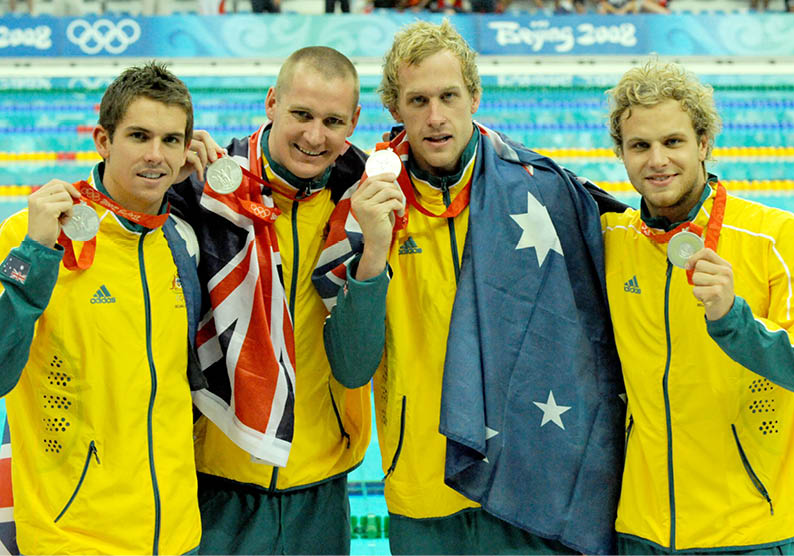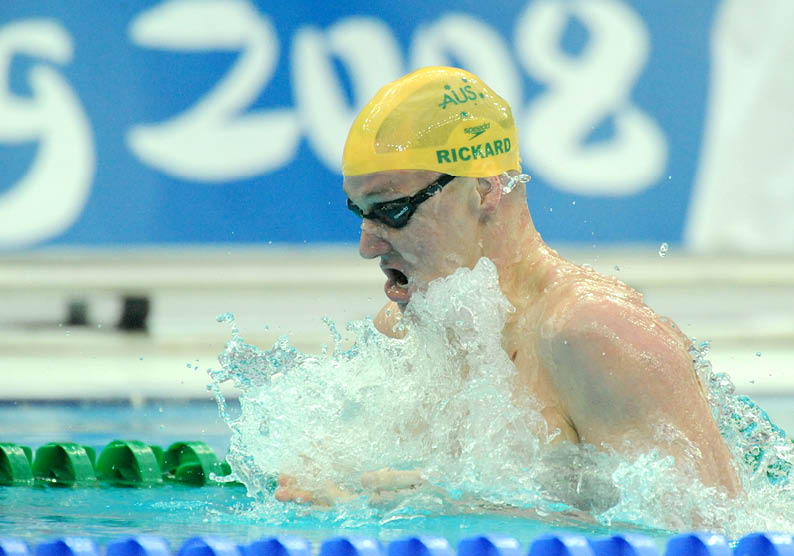Faster, higher, stronger. These are the Olympic ideals, adopted as a motto in 1894 with the launch of the Olympic Movement. Just how far are athletes and nations willing to go to become those ideals? And how far can anti-doping authorities go to protect them? LSJ speaks to athletes and lawyers navigating this precarious minefield in sports law.
Eight years is a long time. To a professional athlete, it is the equivalent of two chances at an Olympic medal, eight World Championship runs, and countless gruelling hours in training. To former Olympic swimmer Brenton Rickard, it is the length of time through which he had to wrack his memory – trawling through old calendars, training timetables, shopping receipts and ingredient lists – to clear his name from a retrospective drug charge that branded him a cheat.
It’s a story that rocked the swimming world in 2020. Eight years after he swam a heat for the Australian 4 x 100m medley relay team that claimed bronze in the 2012 London Games, Rickard received an email from the International Olympic Committee (IOC). It informed him a urine sample he had provided at the Games had been retested and returned a positive result for a banned substance called Furosemide, a banned diuretic that can be used to disguise performance-enhancing drugs.
The result could trigger sanctions including disqualification from the 2012 Games. He and the five other members of the relay team faced losing their medals.
“It was just disbelief. I thought, ‘This can’t be real, this can’t be happening’,” the former Beijing Olympic silver medallist tells LSJ almost two years after the gut-plummeting experience.
“You go a day or two trying to get your head around it. What is this substance and what is this about? And how could it have possibly gotten into my system?
“Pretty early on I had a conversation with experts in the anti-doping field who said, ‘Look, you’re not going to be able to prove it. It was eight years after the fact; there’s almost no way to prove you’re innocent so long after.”
The implications of a retrospective system
Sports fans are, these days, alert to the fact that a small proportion of their favourite athletes won’t be able to resist the temptation to use drugs to enhance their performances.
American cyclist Lance Armstrong opened the world’s eyes a decade ago, when it was revealed the seven-time winner of the Tour de France had been using performance-enhancing drugs in a sport that turned out to be rife with cheating. He had been caught many years after the fact, owing to developments in testing technology that could detect new drugs at lower concentrations.
The world was also recently reminded of the threat of doping on the slopes at the Beijing Winter Olympic Games. Russian athletes were forced to compete under a three-letter code, “ROC”, which stands for Russian Olympic Committee. This was the representative association offered for “clean” athletes allowed to attend the Games, after Russia’s name, flag, and a host of former athletes, were banned from competing.
The four-year ban, which was reduced to two years by the Court of Arbitration for Sport, was instigated when the World Anti-Doping Agency (WADA) found state-sponsored, systematic, and widespread violations of anti-doping rules in the 2014 Sochi Games. Eye-wateringly bad practices, such as Russian officials passing clean urine samples through holes drilled into walls of the anti-doping labs to athletes on their way to be tested, had been reported.
But never has an Australian lost an Olympic medal to a doping charge. Rickard’s was the first high-profile case to threaten that. It also cast light on the dark side of anti-doping investigations from an individual athlete’s point of view.
“I could understand a rule where an athlete is provisionally suspended with no prejudice. But don’t treat them like a criminal. Allow them to train, allow them to defend themselves against the charge, allow them to maintain connections with their team. At the moment, they are completely ostracised [while they try to prove innocence]. I just don’t think it’s a solution”
“Because of these high-profile cheating cases, we’re always cynical. Because we know it does happen. Whenever we hear, ‘Oh it must have been contamination’, we say, ‘yeah right, and Lance Armstrong said he never failed a drug test’,” says Rickard.
“But at the same time, there have been cases where innocent people have been caught up in a doping charge and later found to be innocent but gone through some form of punishment regardless.”
WADA has a lengthy 10-year limitation period for drug testing so that authorities can retest samples as the technology and sensitivity of test facilities improves. The testing facilities had become a lot more sensitive since Rickard gave his sample in 2012, which is why authorities were able to retest and come across a tiny amount of Furosemide in his urine. Sports historian and statistician Bill Mallon found more than 140 athletes were banned or disqualified retrospectively from the London Games via doping sanctions that occurred in this way, including 42 medallists, 13 of which were gold.
Rickard’s legal team sought to appeal the charge in the Court of Arbitration for Sport – the international body established in 1984 to settle disputes in sport – arguing the concentration of the banned substance was so insignificant it was almost certainly a case of unintentional contamination. Fortunately, the situation caused WADA to review and update its minimum reporting levels for diuretics. But it was almost two years before the International Olympic Committee decided to withdraw its case against Rickard when the minimum reporting levels changed. The saga cost him about $50,000 in legal fees and a two-year hiatus from his career in sports event management (he was unable to work with sports while the doping cloud hung over his head). At the time, he told media the situation presented his “worst nightmare”.
“I feel like I was punished by my time in the system. My legal fees were not massive in the scheme of things, I’ve heard of other cases being more. But it’s a significant cost between that and the loss of income for close to two years,” he tells LSJ.
Guilty until proven innocent
Lawyers representing athletes in anti-doping cases call themselves “sport lawyers”, but it’s arguable whether anti-doping rules can be considered law. They only apply to athletes in professional training or competing under rules agreed by the sport’s organising authority. They operate on strict standards of proof – presuming an athlete guilty of cheating simply by the presence of a drug in their system. Reversing that presumption is a high bar to meet when appealing a WADA charge in the Court of Arbitration for Sport. This is especially so in retrospective testing cases like Rickard’s, when any evidence and memory of the event could be approaching a decade old.
As Rickard found out, an anti-doping rule violation is not a criminal charge, but it can be almost devastating. An athlete’s career, reputation, and chances of future employment can become collateral damage in the quest to prove their innocence.

Tim Fuller is a former professional rugby league player who became one of Australia’s leading sports lawyers representing athletes in anti-doping cases. The Special Counsel at Gadens in Brisbane fought for Australian swimmer Shayna Jack when anti-doping authorities found a banned substance called Ligandrol in her urine sample in 2019, in similar circumstances to Rickard. Jack had been an Olympic hopeful but was banned from competing or even training with her teammates for two years between 2019 and 2021 in the lead-up to the Tokyo Olympics.
“If someone is charged with a criminal offence in Australia, the presumption of innocence applies and it applies all the way along in the lead-up to their trial. That doesn’t happen in anti-doping; in sport it’s the reverse,” Fuller tells LSJ.
Fuller explains the impact of the anti-doping ban on Jack was “mentally, psychologically, emotionally” damaging. She was ostracised from the Australian swimming team and forced to train in a lane by herself, at different times to the rest of the team – while her dream of competing at Tokyo slipped away. Fuller says she would call it “a soul-destroying experience”.
“I could understand a rule where an athlete is provisionally suspended with no prejudice. But don’t treat them like a criminal. Allow them to train, allow them to defend themselves against the charge, allow them to maintain connections with their team. At the moment, they are completely ostracised [while they try to prove innocence]. I just don’t think it’s a solution,” Fuller says.
The harshness of the anti-doping system is laid bare when compared to how sports organisations treat athletes charged with criminal offences. For example, Australia’s National Rugby League (NRL) has a no-fault stand-down policy where players are automatically stood down if they are charged with offences carrying jail sentences of more than 11 years. In a recent high-profile case, Dragons star Jack de Belin was charged with five counts of sexual assault and was suspended for three years while he fought the charges. During those three years he was paid his circa-$700,000 salary and continued to train with his teammates, until he was found not guilty on one count and the four other charges were dropped in 2021.
“There are plenty of lawyers that argue there’s no such body of law called ‘sports law’,” Fuller says. “I agree with that to some extent, obviously a lot of the work we do in sports law is underpinned by contract law. But these anti-doping rules are specific to sport; the rules do not apply outside the sport. Any decisions and jurisprudence that develops in anti-doping cases becomes part of that body of law. You can’t appeal them to the High Court of Australia.”
Who decides what ‘performance-enhancing’ is?
While WADA has the most widely accepted anti-doping rules, which are applied to international competitions like the Olympics, not all sports agree with them. Huge organisations worth billions of dollars are not signatories to the WADA code, including the US National Football League (NFL) which draws more than a hundred million viewers globally to the annual Super Bowl.
UNSW sports law professor Deborah Healey had a long career as a sports lawyer at top-tier firms and has sat on several boards for sport organisations, including as a current director at NSW Rugby League. She says high-profile doping cases have made her “cynical about sport” because of the evidence of doping in many codes. She tells LSJ the world has almost certainly watched athletes in the recent Winter Olympics being assisted by performance-enhancing drugs, and any athletes caught in the years after the Games may only represent the tip of the iceberg.
“You can’t trust anyone. I mean, who predicted Lance Armstrong? When you look at how he was enabled by the people around him. People didn’t want to shatter the icon image, they wanted him to be that legend he presented,” she says.
Healey edited a book called Doping in sport: the myth of the level playing field?, and wrote a chapter in it examining the difficulties involved in defining and banning “performance-enhancing” drugs. In it, she notes that performance-enhancing drugs are banned partly because they create an uneven playing field by advantaging the drug-takers. But, she writes, was there ever a truly “even” playing field in sport?

“I could understand a rule where an athlete is provisionally suspended with no prejudice. But don’t treat them like a criminal. Allow them to train, allow them to defend themselves against the charge, allow them to maintain connections with their team. At the moment, they are completely ostracised [while they try to prove innocence]. I just don’t think it’s a solution”
Genetic and physical advantages exist and are not regulated in sport. Neither are diets, training methods, some vitamin supplements or protein powders that didn’t exist until recently. Many forms of corrective surgery such as knee replacements are also allowed. Paralympic sprinting champion Oscar Pistorius was ultimately allowed to run on his “blades” because they were deemed not to give him an advantage over other competitors – but they surely enhanced his own personal performance?
“It’s a bit of an impossible situation to police,” says Healey. “Some people say it should be open slather. But you can imagine it would encourage everyone to dope and the damage that might do to human bodies.”
It’s well documented that doping can damage the physical health of athletes. It is also thought to affect the integrity of competition and create unfair advantages. For these reasons, Healey says strict rules are necessary. But has the moment for sanctions passed once a drug-taking athlete has already stood on the podium and claimed the medal at the event? Healey says no; competitors who would otherwise have won are vindicated when awarded their rightful prize many years down the track.
“[Former Australian Olympic sprinter] Raelene Boyle still wants her gold medals from 1972. Frankly, she should have them,” Healey says. Boyle was a three-time silver medallist beaten by East German Renate Stecher, who was later revealed to have been on anabolic steroids under a state-sponsored
doping regime.
“Even though the rules can operate harshly, I don’t think we would want it to be easy. Look at Shayna Jack, that was a long and tortuous process, but she got there in the end. It’s a noble goal worth perservering with.”

Strict liability in an imperfect world
A study of 100 Australian anti-doping cases by James Cook University Professors Stephen Moston and Terry Engelberg found at least 23 per cent of sanctioned cases involved claims of accidental or inadvertent doping. The report, “Guilty Until Proven Innocent (and Then Still Guilty)” found athletes who claim accidental doping are typically sanctioned as severely as deliberately doping athletes.
An interesting quirk the public may not realise is the WADA code only contains two anti-doping violations that relate directly to drugs being found in an athlete’s body. In comparison, there are nine that deal with indirect violations, including not being where you said you would be for three out-of-competition drug tests, associating with someone under sanction for violating an anti-doping rule, and discouraging someone from reporting potential violations to authorities.
Such indirect violations have caused athletes to be vilified and branded “drug cheats” despite no direct evidence they were using prohibited substances. US 100m sprinter Christian Coleman was banned for two years in 2019 after missing three out-of-competition drug tests in a year. This was despite the Court of Arbitration for Sport deciding it believed Coleman did not dope and reducing his ban to 18 months.
In Rickard’s case, the backdated test of his urine contained what his lawyers called an “exceedingly small” concentration of the banned substance in his urine – less than 10 nanograms per million grams of urine, or less than 10 in a billion. This is less than the threshold for contamination that medical-grade testing systems can detect when ensuring purity in over-the-counter drugs. Any Australian pharmacy could be selling paracetamol with the same amount of contamination, and it would be completely legal.
Rickard’s legal team’s theory was that the Furosemide may have accidentally entered his body through painkillers that can sometimes contain traces of other drugs. He was eventually able to cast enough doubt on WADA’s claim of deliberate cheating, by showing the potential for miniscule concentrations of banned drugs to enter the body in a variety of ways – from paracetamol to a dirty gym surface. It helped that diuretics similar to Furosemide have been known contaminants in previous anti-doping cases.
Rickard was utterly relieved when WADA dropped the charges, but disappointed by the cost to his mental health and reputation.
“I think there’s an understanding in the sporting community about how strict the anti-doping rules have become, because of those high-profile cases where people have been caught deliberately doping and cheating,” says Rickard.
“But the inverse of that is, you’re asking athletes to be perfect in a world that’s not perfect. None of the medications we take are. You risk punishing innocent people to increase your chances of catching cheats.
“I’m all for catching cheats but a system that punishes innocent people is not a good system.”




